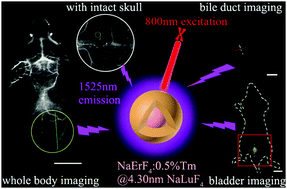Er3+ self-sensitized nanoprobes with enhanced 1525 nm downshifting emission for NIR-IIb in vivo bio-imaging†
Abstract
Traditional sensitizer (Yb3+ or Nd3+) and activator (Er3+) co-doped lanthanide-based nanoprobes possessing emission of Er3+ at 1525 nm have attracted much attention in NIR-IIb bio-imaging. However, the 1525 nm fluorescence efficiency was not high enough in such co-doped systems due to the serious back energy transfer from the activator to the sensitizer, resulting in a lot of excitation energy loss. Herein, we have designed an efficient NIR-IIb nanoprobe Er3+ self-sensitized NaErF4:0.5%Tm3+@NaLuF4, where substantially all the excitation energy could contribute to Er3+ ions and most energy transfer processes were confined among Er3+ ions, avoiding the energy dissipation by heterogeneous sensitizer ions. The influence of the types of epitaxial heterogeneous shells, the doping effect and optimal doping concentration of Tm3+ ions, as well as the critical shell thickness for obtaining the surface quenching-assisted downshifting emission are systematically investigated to acquire the most efficient 1525 nm luminescence under 800 nm excitation. The quantum yield in the 1500–1700 nm region reached 13.92%, enabling high-resolution through-skull cerebrovascular microscopy imaging and large-depth in vivo physiological dynamic imaging with an extremely low excitation powder density of 35 mW cm−2. The designed nanoprobe can be potentially used for brain science research and clinical diagnosis.



 Please wait while we load your content...
Please wait while we load your content...